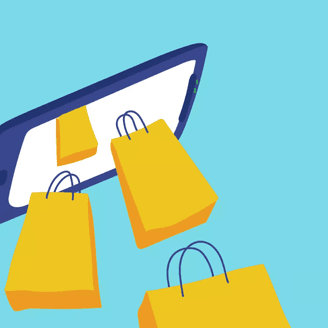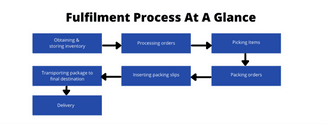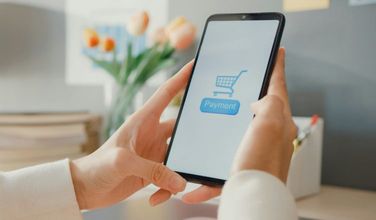- Osome Blog HK
- An Online Seller's Guide to Ecommerce Fulfillment & Shipping
An Online Seller's Guide to Ecommerce Fulfillment & Shipping
- Modified: 6 May 2025
- 7 min read
- Ecommerce


Emma Drummond
Author
Emma’s spent 12 years in marketing and advertising in the banking and financial sector. She tries to keep her writing fresh and convincing. One thing she loves more than writing is her cat, Bumpy.
Here’s a guide to ecommerce fulfilment and shipping for new sellers in Hong Kong looking to drive revenue from online sales. Find out more about the methods, models and software that’ll help you scale the business you’ve worked hard to build.
The most important “p” in this guide isn’t “packaging”. It’s profit. Because as a Hong Kong business owner, you have the potential to establish an ecommerce fulfilment and shipping strategy that could have a lasting and positive effect on your company’s bottom line.
In this article, we’ll unpack ways you can leverage the opportunities of logistics that’ll drive revenue and growth for your HK-based ecommerce business. We’re sharing this with you because we believe that entrepreneurs should do their best to focus on activities that can grow their company.
Meanwhile, for activities that are routine but necessary, like compliance tasks or accounting, we can take care of that. Consider us your on-demand experts who’ll focus on taking care of your ecommerce accounting while you get all other aspects of your business sorted to sell online.
What Is the Definition of Fulfillment in Ecommerce?
When we refer to the definition of fulfilment in ecommerce, we’re talking about the process from the moment your customer hits “CHECKOUT” to the moment their package is delivered to them. Shipping forms part of the overall fulfilment process, specifically referring to the movement or transit of a package from its original storage location to its final physical destination.

Ecommerce Fulfillment in Hong Kong: What’s In It for Me?
First, there’s the benefit of lining yourself up for more conversions and more sales (national and international). Second, there’s the obligation as a business owner in Hong Kong. If you’re planning to sell online, fulfilment is your responsibility. While you may not have a choice about that duty, you DO have a choice about how you’ll handle the processing of your online orders.
Considering that Hong Kong’s one of Asia’s main global shipping hubs, it’s teeming with opportunities and access for ecommerce brands. There are attractive tax structures and cost-effective product manufacturing avenues via China and nearby Taiwan. It’s no surprise that fulfilment and shipping from Hong Kong to destinations across the globe - from Asia and Oceania to the Americas and Europe - is favoured by new and long-established sellers.
These are the 3 main methods of fulfilment. We’ll cover each in a detailed overview a bit further down but at a glance, they are:
- In-house fulfilment
- Dropshipping
- Third-party Logistics aka3PL
Strategy for Local & Global Sellers in Hong Kong
You may be right at the start of establishing your fulfilment strategy or perhaps even refining one that’s existing. The good news is that Hong Kong’s a duty-free port. That means the importing and exporting of goods is made a little less complex due to the trade-friendly regulations which ease the financial pressure on your business pocket when dealing with import duties and taxes.
You don’t have to have a company registered in Hong Kong in order to make use of a Hong Kong-based fulfilment centre.
Let’s walk through a couple of the things a new seller like you may need to consider through the lens of Ren, who is the owner of a small business called “Face it, Darling!”. She runs an online shop selling organic beauty products.
Example
Shipping costs & methods:
Ren’s got two options on opposite ends of the spectrum - she could offer free shipping or she could pass the full cost of shipping to her customers. She chooses flat-rate shipping. This is a happy medium where Ren absorbs some of the costs without putting her profit margins at too much risk.
Products weights:
When a new product’s added to the Face it, Darling! catalogue, Ren measures, weighs and records product specs. This info serves a dual purpose: it’s added to product descriptions for customers to view online and also factored in when she’s working out total shipping costs and product prices.
Sourcing packaging materials or suppliers:
Face it, Darling! has distinctive packaging which Ren sees as enhancing her long-term customer acquisition strategy. She plans to firmly entrench her brand reputation and customer base, then she’ll consider free packaging provided by couriers. Until then, she undertakes the cost and task of sourcing her materials taking care to seek packaging with the smallest volume and weight.
Packaging preferences (and presentation):
Face it, Darling! products are always meticulously wrapped in metallic silver paper (representing a mirror) with bold accents of pink ribbon (representing a touch of lipstick). Ren consciously uses these aesthetic cues to reflect her brand image because she knows that it’ll make a memorable and eye-catching statement. Boxes are filled with dunnage, and the pretty package is weighed with all custom packing materials factoring into shipping prices.
You’ll need a payment gateway to authenticate and authorise ecommerce transactions quickly and safely. We’ve put together a top 10 list of payment gateway options to help you find what works best for your business.
Calculating Ecommerce Product Shipping Costs
Here’s how Ren may calculate the total price of her newly-launched tinted lip balm so it includes ecommerce shipping costs:
| Cost of lip balm (product) | HK$15 |
| Cost of packaging materials | HK$1 |
| Cost of shipping | HK$6 |
| Fee for credit card | HK$2 |
| Product profit margin | 45% |
| TOTAL PRICE: | $34.8 |
Remember: Any final decisions you make should be informed by the underlying financial data of your business. When you do your accounting with Osome, you’ll be able to have access to your data anytime, anywhere on the Osome app.
Ecommerce Fulfillment & Shipping Models
1 Direct order fulfilment (or self-fulfilment)
The entire process happens in-house (even IN your house) using all your facilities, supplies and assets.
What’s to like?
- Easy implementation
- Startup costs are the lowest
- Packaging can be customised
- You’re in control 100% of the time
What’s not to like?
- Limited opportunity to scale
- Time-consuming
- Storage space is limited to what you’ve got
- No shipping or bulk storage discounts
Best suited to:
Startups selling less than 100 items per month, like the artist who features limited edition work on Etsy or C2C platforms similar.
2 Third-party logistics
All functions of the supply chain are outsourced and managed through external resources
What’s to like?
- Easy integration & automated, time-saving tech
- Quick setup & easy to scale
- View of sales data for practical insights
- Access large network of providers & better shipping rates
What’s not to like?
- Customer service is not 100% in your control
- Supply chain reliance on 3rd-party vendors for success
- Less opportunity for personalisation of packing
- Storage fees are often rigid
Best suited to:
Startups who lack resources looking to scale or focus efforts on product development and marketing.
3 Dropshipping
Ecommerce orders go directly to your chosen supplier or manufacturer and they sort out the rest. Products are never handled directly by you.
What’s to like?
- Low startup costs
- Order fulfilment costs are low
- Updating inventory is a breeze
- Inventory costs are low
- Only pay for what you sell
What’s not to like?
- Shipping and handling is out of your control
- Sales are reliant on supplier stock
- Customer service not managed by you
- No bulk pricing & shorter lead times
- Lower profit margins
Best suited to:
A good option for startups just starting, acting as a supplementary side hustle without full-time obligations or risk
Fulfilment Centres Services
A fulfilment company takes the reins of processing, warehousing and storage of your goods right down to the shipping of the actual orders. So when a customer hits that glorious “CHECKOUT” button, signals would be sent straight to Ren’s fulfilment center. Then, they can get to work to pick, pack, and ship orders on her behalf and prep them according to the Face it, Darling! packaging particulars.
It’s a pretty neat way to alleviate hands-on responsibilities linked to hiring, managing stock, tech equipment, ops and infrastructure. When Ren’s order numbers rise and she’s ready to scale, here are a few things she may consider when looking for a suitable 3PL fulfilment partner:
- Ecommerce platform integration: It’s a non-negotiable that Ren finds a provider that can successfully integrate her ecommerce platforms. User-friendly technology is a must-have for someone as busy as she is.
- Multichannel integration: Ren’s Face it, Darling!Products are sold online via Amazon and Shopify. She hopes to extend to other platforms whose ecommerce software offers easy integration to accommodate her needs.
- Shipping provider integration: Ren needs the assurance that ecommerce shipping will be a seamless process. A 3PL partner that helps her complete more orders is a partner that’ll help her biz scale.
- Costs & fees: Are the financial obligations for warehousing and fulfilment realistic, sustainable, fixed, scalable? Do their price models accommodate startups like hers or tiered (or are there hidden fees that lock her into obligations she’s not able to meet?)
- Shipping turnaround times: Are they speedy and in line with what her customers have come to expect? Can she maintain these delivery times and still benefit from a white label service so she can keep up with building her brand?
- Product volumes: Do they ship broad & vast or specific & specialised? Or both? And whatever their volumes, does this model align with Face it, Darling!?
- Customer support: Is there a single person Ren can reach out to? Do they offer live chat she can access on her commute for a quick query? Does she have a direct phone line in case something goes wrong?
- Real-time reporting & inventory: What management system or ecommerce fulfillment software is the driving force behind warehousing capabilities? Will it scale, suit or complement Ren’s products? Is it easy to get oversight when she needs to view an analytics dashboard at-a-glance?
- Network of fulfilment centers: To reduce her shipping costs and get products to customers quicker, Ren’s best option is a 3PL with the added benefit of centres in different locations in Hong Kong. With the added tax and duty benefits and the proximity of the China-to-Hong-Kong trucking route, Ren will be able to restock inventory to scale up her international shipping.
Hong Kong & China Ecommerce Fulfillment Centers:
- Asendia
- Borderless360
- ChinaDivision
- DHL Hong Kong
- Easyship
- EXchain
- Floship
- Morning Express & Logistics
- NextSmartShip
- Send From China
- SF international
- Shipwire
- V Logic
- ZhenHub
From New Seller to Seasoned Ecommerce Sales
The world of ecommerce can be exhilarating in a hub like Hong Kong but the weight of invoices, reports and taxes can quickly dull its sparkle. That’s where Osome comes in. In just 2 minutes, we can connect to your ecommerce platform and free you from manual accounting. Talk to us about a tailored accounting plan that’ll save you money, time and the entrepreneur’s ever-elusive luxury of sleep.






